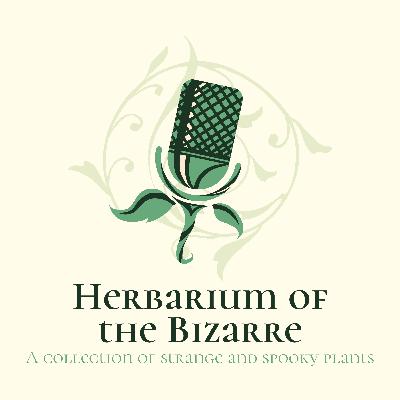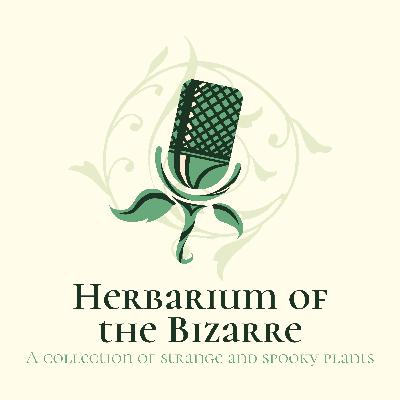Discover Herbarium of the Bizarre
Herbarium of the Bizarre

93 Episodes
Reverse
Pass the cranberry sauce! Did you read that to the tune of the Bob’s Burgers song? I hope so.Music by James MilorInformation provided by:https://www.cranberryinstitute.org/cranberry-health-researchhttps://www.pbs.org/newshour/science/the-botany-behind-why-cranberries-became-a-thanksgiving-staplePeterson Field Guide to Medicinal Plants and Herbs of Eastern and Central North America (3rd ed.) by Steven Foster and James A. Duke (2014)https://www.cranberries.org/Herbs at a Glance: A Quick Guide to Herbal Supplements by the National Center for Complementary and Alternative Medicine (2009)Cranberry: Chemical composition, antioxidant activity and impact on human health by Boris V. Nemzer, et al. (2022). Molecules, 27(5), pg. 1503. https://doi.org/10.3390/molecules27051503Peterson Field Guides: Edible Wild Plants of Eastern and Central North America by Lee Allen Peterson (1977)The Kitchen Witch Companion by Sarah Robinson and Lucy H. Pearce (2023)Domestication, genetics, and genomics of the American cranberry by Nicholi Vorsa and Juan Zalapa in Plant Breeding Reviews, Volume 43 by Irwin Goldman (Ed.) (2019). https://doi.org/10.1002/9781119616801.ch8
Sorry it sounds so echo-y. I’m dog/housesitting for my parents, so I’m not in my usual recording space. Ruby the Beagle says “hi.” Music by James Milor from PixabayInformation provided by:Diphylleia grayi-inspired stretchable hydrochromics with large optical modulation in the visible–near-infrared region by Guofa Cai, et al. (2018). ACS Applied Materials and Interfaces, 10(43), pg. 37685-37693. https://doi.org/10.1021/acsami.8b12490 [Abstract]https://www.thespruce.com/skeleton-flower-plant-profile-4802581Cytological effects of chemicals on tumors, XXV: Further studies on the effect of Diphylleia grayi extracts on tumor cells by Kohtaro Yamamoto and Yanagi Kimura (1964). Journal of the Faculty of Hokkaido University, Series 6 - Zoology, 15(3), pg. 347-352.https://www.scienceabc.com/nature/skeleton-flowers-how-does-this-white-flower-turn-transparent-in-the-rain.htmlhttps://en.wikipedia.org/wiki/Diphylleia_grayihttps://www.bhg.com/how-to-plant-and-grow-skeleton-flower-8553286Diphylleia grayi-inspired intelligent hydrochromic adhesive film by Gang Yeol Yoo, et al. (2020). ACS Applied Materials and Interfaces, 12(44), pg. 49982-49991. https://doi.org/10.1021/acsami.0c13185 [Abstract]Diphylleia Grayi-inspired intelligent temperature-responsive transparent nanofiber membranes by Cengceng Zhao, et al. (2024). Nano-Micro Letters, 16(65). https://doi.org/10.1007/s40820-023-01279-z
There seems to be disagreement whether it ought to be spelled narrow-leafed or narrow-leaved. Neither is easy to say, for the record.Music by James Milor from PixabayInformation provided by:https://www.bbc.com/news/science-environment-17100574https://www.nationalgeographic.com/science/article/120221-oldest-seeds-regenerated-plants-sciencehttps://www.livescience.com/2602-extinct-tree-christ-time-rises-dead.htmlhttps://www.abc.net.au/science/articles/2012/02/22/3436826.htmGermination, genetics, and growth of an ancient date seed by Sarah Sallon, et al. (2008). Science, 320(5882), pg. 1464. https://doi.org/10.1126/science.1153600 [Abstract]https://www.selinawamucii.com/plants/caryophyllaceae/silene-stenophylla/Exceptional seed longevity and robust growth: Ancient Sacred Lotus from China by J. Shen-Miller, et al. (1995). American Journal of Botany, 82(11), pg. 1367-1380. https://doi.org/10.2307/2445863https://en.wikipedia.org/wiki/Oldest_viable_seedhttps://en.wikipedia.org/wiki/Silene_stenophyllaRegeneration of whole fertile plants from 30,000-y-old fruit tissue buried in Siberian permafrost by Svetlana Yashina, et al. (2012). Proceedings of the National Academy of Sciences, 109(10), pg. 4008-4013. https://doi.org/10.1073/pnas.1118386109
This episode ended up being way more involved that I expected, but I learned so much, and I thought I knew Dutch Elm Disease pretty well already. Hopefully, y’all will learn a lot, too.Music by James Milor from PixabayInformation provided by:https://www.dontmovefirewood.org/pest_pathogen/dutch-elm-disease-html/https://www.apsnet.org/edcenter/pdlessons/Pages/DutchElm.aspxhttps://www.forestresearch.gov.uk/tools-and-resources/fthr/pest-and-disease-resources/dutch-elm-disease-ophiostoma-novo-ulmi/A Dictionary of Plant Pathology by Paul Holliday (1989)https://content.ces.ncsu.edu/native-elm-bark-beetlehttps://themanitoban.com/2009/11/dutch-elm-vaccine-tested-in-winnipeg/530/https://www.unisci.com/stories/20013/0828015.htmhttps://en.m.wikipedia.org/wiki/Dutch_elm_disease
We will resume my trilogy of invasive plants next week once I find my mind. Has anyone seen it?Music by James Milor from PixabayInformation provided by:https://www.scientificamerican.com/blog/running-ponies/animal-or-vegetable-legend-of-the-vegetable-lamb-of-tartary/The Vegetable Lamb of Tartary: A curious fable of the cotton plant by Henry Lee (1887)https://www.nybg.org/poetic-botany/barometz/https://www.metmuseum.org/perspectives/curious-tale-of-vegetable-lambThe Vegetable Lamb of Tartary by Alice F. Tryon (1957). American Fern Journal, 47(1), pg. 1-7.https://en.wikipedia.org/wiki/Vegetable_Lamb_of_Tartary
Don't worry, I'm okay. My car is very much not okay, unfortunately.
If you’re thinking of planting a Privet, you should pivot and plant something else. Well, if you live in North or Central America, anyway, but that doesn’t rhyme.Music by James Milor from PixabayInformation provided by:https://www.lewisginter.org/chinese-privet/https://www.invasivespeciesinfo.gov/terrestrial/plants/chinese-privethttps://plants.ces.ncsu.edu/plants/ligustrum-japonicum/https://plants.ces.ncsu.edu/plants/ligustrum-sinense/https://triangleland.org/company-news/species-spotlight-chinese-privethttps://www.se-eppc.org/manual/privet.htmlhttps://en.m.wikipedia.org/wiki/Ligustrum_sinense
I have a complicated relationship with this stinky dead fish tree.For your entertainment, a Reddit thread about Bradford Pears: https://www.reddit.com/r/arborists/comments/1bn1wpv/why_bradford_pear_is_so_hated/Music by James Milor from PixabayInformation provided by:https://indiananativeplants.org/2013/callery-pear-a-bad-bad-plant-in-bloom-right-now/https://www.bhg.com/gardening/trees-shrubs-vines/trees/bradford-pear-tree/https://mdc.mo.gov/discover-nature/field-guide/callery-pear-bradford-pearhttps://www.invasivespeciesinfo.gov/terrestrial/plants/callery-pearhttps://plants.ces.ncsu.edu/plants/pyrus-calleryana/https://extension.umd.edu/resource/bradford-pear/https://www.invasivespeciesva.org/species/callery-pearhttps://dyckarboretum.org/callery-pear-cut-them-down/
Meet the world’s biggest (and possibly stinkiest) flowers.Music by James Milor from PixabayInformation provided by:https://www.cnn.com/2020/01/03/world/worlds-largest-flower-indonesia-scn-trnd/index.htmlhttps://www.britannica.com/plant/RafflesiaPlants That Kill: A Natural History of the World’s Most Poisonous Plants by Elizabeth A. Dauncey and Sonny Larson (2018)https://www.kew.org/plants/rafflesia-arnoldihttps://parasiticplants.siu.edu/Rafflesiaceae/Raff.arn.page.htmlhttps://richardniesenbaum.com/plants-people-2/rafflesia/https://www.harvardmagazine.com/2017/02/colossal-blossomhttps://en.m.wikipedia.org/wiki/Rafflesia
If you’re in the U.S., I hope you try and have a happy 4th of July. And as a public safety professional in my day job, I must remind you to please not start any fires or injure anyone with fireworks. ‘Kay thanks.Music by James Milor from PixabayInformation provided by:https://www.popsci.com/environment/fairy-lantern-japan-extinct-fungi/https://www.discoverwildlife.com/plant-facts/thismia-malayana-factshttps://www.livescience.com/61925-fairy-lantern-plant-rainforest.htmlhttps://phys.org/news/2024-02-species-story.htmlRediscovery of Thismia neptunis (Thismiaceae) after 151 years by Michal Sochor, et al. (2018). Phytotaxa, 340(1), 71-78. https://doi.org/10.11646/phytotaxa.340.1.5Fairy lanterns in focus by Chris J. Thorogood and Siti-Munirah Mat Yunoh (2021). Plants People Planet, 3(6), 680-684. https://doi.org/10.1002/ppp3.10217Fairy lanterns may lure pollinators by mimicking fungi by Kenji Suetsugu and Masahiro Sueyoshi (2021). Frontiers in Ecology and the Environment, 19(4), 233. https://doi.org/10.1002/fee.2342https://en.m.wikipedia.org/w/index.php?title=Thismiahttps://en.m.wikipedia.org/wiki/Thismia_rodwayi
Be a lavender menace.Music provided by James Milor from PixabayInformation provided by:Flowers and Their Meanings: The Secret Language and History of Over 600 Blooms by Karen Azoulay (2023)https://bouqs.com/blog/capricorn-birth-flower/https://www.britannica.com/plant/lavenderhttps://www.britannica.com/topic/Lavender-ScareCunningham’s Encyclopedia of Magical Herbs (2nd ed.) by Scott Cunningham (2014)Herb Magic for Beginners: Down-to-earth Enchantments by Ellen Dugan (2016)https://www.hrc.org/resources/lavender-graduationThe Drunken Botanist: The Plants That Create the World’s Greatest Drinks by Amy Stewart (2013)https://www.osgf.org/blog/2020/6/29/vi0rxptrmtd4v8n2epbm3otxj56z5oLavender and the nervous system by Peir Hossein Koulivand, Maryam Khaleghi Ghadiri, and Ali Gorji (2013). Evidence-Based Complementary Alternative Medicine, https://doi.org/10.1155/2013/681304Herbs at a Glance: A Quick Guide to Herbal Supplements by the National Center for Complementary and Alternative Medicine (2009)https://www.nccih.nih.gov/health/lavenderhttps://daily.jstor.org/four-flowering-plants-decidedly-queered/A Floral Grimoire: Plant charms, spells, recipes, and rituals by Patricia Telesco (2024)Nature’s Remedies: An Illustrated Guide to Healing Herbs by Jean Willoughby (2016)https://en.m.wikipedia.org/wiki/Lavandulahttps://en.m.wikipedia.org/wiki/Lavender_Scare
Support the Pansy Project and get a cute shirt: https://birdscanflystore.com/collection/the-pansy-project/Music by James Milor from PixabayInformation provided by:Flowers and Their Meanings: The Secret Language and History of Over 600 Blooms by Karen Azoulay (2023)https://bouqs.com/blog/capricorn-birth-flower/Cunningham’s Encyclopedia of Magical Herbs (2nd ed.) by Scott Cunningham (2014)Garden Witch’s Herbal by Ellen Dugan (2011)https://www.osgf.org/blog/2020/6/29/vi0rxptrmtd4v8n2epbm3otxj56z5oPeterson Field Guide to Medicinal Plants and Herbs of Eastern and Central North America (3rd ed.) by Steven Foster and James A. Duke (2014)https://www.kew.org/read-and-watch/plants-LGBTQ-symbolshttps://daily.jstor.org/four-flowering-plants-decidedly-queered/A Floral Grimoire: Plant charms, spells, recipes, and rituals by Patricia Telesco (2024)https://thepansyproject.com/about/https://gardeningsolutions.ifas.ufl.edu/plants/ornamentals/pansies/
Roses are (sometimes) red,Violets are (sometimes) blue,And if you ask Sappho,Violets are gay, too!Happy Pride Month 🌈Music by James Milor from PixabayInformation provided by:Flowers and Their Meanings: The Secret Language and History of Over 600 Blooms by Karen Azoulay (2023)https://bouqs.com/blog/violet-flower-meaning-symbolism/Cunningham’s Encyclopedia of Magical Herbs (2nd ed.) by Scott Cunningham (2014)Peterson Field Guide to Medicinal Plants and Herbs of Eastern and Central North America (3rd ed.) by Steven Foster and James A. Duke (2014)https://www.osgf.org/blog/2020/6/29/vi0rxptrmtd4v8n2epbm3otxj56z5oWild Flowers of North Carolina and Surrounding Areas by William S. Justice and C. Ritchie Bell (1979)https://botanicgardens.uw.edu/about/blog/2021/12/21/queer-botany-the-sapphic-violet/Peterson Field Guides: Edible Wild Plants of Eastern and Central North America by Lee Allen Peterson (1977)PinkNews. (27 November 2024). Violet necklaces have become a sought-after lesbian accessory, but what is the history behind the trend? [Photograph]. Instagram. https://www.instagram.com/p/DC49dz8thuV/?igsh=X2xVeEQ2Y0Jlhttps://daily.jstor.org/four-flowering-plants-decidedly-queered/National Audubon Society Field Guide to North American Wildflowers: Eastern Region (2nd ed.) by John W. Thieret, William A. Niering, & Nancy C. Olmstead (2001)Collins Gem: Wild Flowers by Martin Walter (2002)https://wildfoods4wildlife.com/monographs/violets/https://www.woodlandtrust.org.uk/trees-woods-and-wildlife/plants/wild-flowers/sweet-violet/
These extra-special trees are similar to both conifers and fruit trees, but they are actually something much, much older. Ginkgoes are the only tree species around today that was alive at the same time as dinosaurs! 🦕 How cool is that?Music by James Milor from PixabayInformation provided by:https://www.healthline.com/nutrition/ginkgo-biloba-benefitsMedicinal Plants at Home by Maria Transito Lopez Luengo and Carlota Manez Ariso (2015)https://www.mayoclinic.org/drugs-supplements-ginkgo/art-20362032Herbs at a Glance: A Quick Guide to Herbal Supplements by the National Center for Complementary and Alternative Medicine (2009)https://www.scientificamerican.com/blog/guest-blog/botanical-sexism-cultivates-home-grown-allergies/https://www.obga.ox.ac.uk/article/seeds-from-hiroshima-atomic-bomb-survivor-trees-planted-at-oxford-botanic-gardenhttps://tylerarboretum.org/ginkgo-biloba-an-ancient-species-in-a-modern-world/https://arboretum.ua.edu/whats-growing-on/ginkgo-ginkgo-biloba/https://en.m.wikipedia.org/wiki/Ginkgo_bilobaNature’s Remedies: An Illustrated Guide to Healing Herbs by Jean Willoughby (2016)
Is it really possible that these trees walk around the rainforest like the Ents in Lord of the Rings?I forgot to mention that there won’t be an episode next week. Here’s your one-week notice that I’ll be on vacation next Friday. ✈️Music by James Milor from PixabayInformation provided by:Stilt-Root Walking by an Iriateoid Palm in the Peruvian Amazon by John H. Bodley and Foley C. Benson (1980). Biotropica, 12(1), pg. 67-71. https://doi.org/10.2307/2387775https://www.sciencealert.com/a-persistent-rumor-suggests-this-tree-can-walk-around-but-is-it-trueThe function of stilt roots in the growth strategy of Socratea exorrhiza (Arecaceae) at two neotropical sites by Gregory R. Goldsmith and Rakan A. Zahawi (2007). International Journal of Tropical Biology and Conservation, 55(3). https://doi.org/10.15517/rbt.v55i3-4.5955 [Abstract]https://www.treeres.com/the-walking-tree-phenomenon-unraveling-the-secrets-of-socratea-exorrhiza/https://www.natureandculture.org/directory/walking-palm-trees/https://en.m.wikipedia.org/wiki/Socratea_exorrhizaThe epiphyte vegetation of the palm Socratea exorrhiza: Correlations with tree size, tree age and bryophyte cover by Gerhard Zotz and Birgit Vollrath (2003). Journal of Tropical Ecology, 19, pg. 81-90. DOI: 10.1017/S0266467403003092Tropical Plants of Costa Rica by Willow Zuchowski (2007)
Today, at long last, I am revealing my favorite fact about witches’ flying ointment. 🧹Music by James Milor from PixabayInformation provided by:https://www.gothichorrorstories.com/witches-garden/witch-garden-feature/witches-garden-plants/henbane/Flowers and Their Meanings: The Secret Language and History of Over 600 Blooms by Karen Azoulay (2023)https://www.britannica.com/plant/henbaneCunningham’s Encyclopedia of Magical Herbs (2nd ed.) by Scott Cunningham (2014)Plants That Kill: A Natural History of the World’s Most Poisonous Plants by Elizabeth A. Dauncey and Sonny Larson (2018)Herbal Magick: A guide to herbal enchantments, folklore, and divination (2nd ed.) by Gerina Dunwich (2019)https://www.europeana.eu/en/exhibitions/magical-mystical-and-medicinal/henbanehttps://www.botanical.com/botanical/mgmh/h/henban23.htmlhttps://sites.evergreen.edu/plantchemeco/henbane-medicine-andor-magic/Collins Gem: Wild Flowers by Martin Walter (2002)https://www.fs.usda.gov/wildflowers/ethnobotany/Mind_and_Spirit/henbane.shtmlhttps://en.m.wikipedia.org/wiki/Hyoscyamus_niger
A.k.a. the California Pitcher Plant or the Cobra Lily. It’s not a lily, not even a little bit, but it does look surprisingly serpentine. 🐍Music by James Milor from PixabayInformation provided by:The cobra's tongue: Rethinking the function of the “fishtail appendage” on the pitcher plant Darlingtonia californica by David W. Armitage (2016). American Journal of Botany, 103(4), pgs. 780-785. https://doi.org/10.3732/ajb.1500524https://www.fs.usda.gov/wildflowers/plant-of-the-week/darlingtonia_californica.shtmlhttps://www.kqed.org/science/12317/predatory-plant-lure-of-the-cobra-lilyhttps://www.carnivorousplantresource.com/the-plants/cobra-lily/Pollination Biology of Darlingtonia californica (Sarraceniaceae), the California Pitcher Plant by George A. Meindl and Michael R. Mesler (2011). Madroño, 58(1), pgs. 22-31. [Abstract] https://doi.org/10.3120/0024-9637-58.1.22https://www.cnps.org/citizen-science/carnivorous-plants-in-meadows-and-fens-6749https://en.m.wikipedia.org/wiki/Darlingtonia_californica
The carnivorous plants are back, and this time we’re looking at my favorite bug traps, Sundews!I forgot to mention in the intro that I’m going to be at RavenCon in Richmond, VA this weekend—actually, as this airs, I’m probably already on my way—and AtomaCon in North Charleston, SC next weekend. Come say “hi!”Music by James Milor from PixabayInformation provided by:Peterson Field Guide to Medicinal Plants and Herbs of Eastern and Central North America (3rd ed.) by Steven Foster and James A. Duke (2014)https://www.nwf.org/Educational-Resources/Wildlife-Guide/Plants-and-Fungi/SundewsNational Audubon Society Field Guide to North American Wildflowers: Eastern Region (2nd ed.) by John W. Thieret, William A. Niering, & Nancy C. Olmstead (2001)https://en.m.wikipedia.org/wiki/DroseraNanofibers and nanoparticles from the insect-capturing adhesive of the Sundew (Drosera) for cell attachment by Mingjun Zhang, et al. (2010). Journal of Nanobiotechnology, 8(20). https://doi.org/10.1186/1477-3155-8-20
Watch the real-life Zombie Fungus in action: https://www.youtube.com/watch?v=XuKjBIBBAL8Music by James Milor from PixabayInformation provided by:https://screenrant.com/girl-all-gifts-fungal-infection-hungries-explained/https://www.webmd.com/vitamins-and-supplements/cordycepsInterkingdom host jumping underground: Phylogenetic analysis of entomoparasitic fungi of the genus Cordyceps by Naruo Nikoh and Takema Fukatsu (2000). Molecular Biology and Evolution, 17(4), pg. 629-638. https://doi.org/10.1093/oxfordjournals.molbev.a026341 https://www.scientificamerican.com/blog/but-not-simpler/the-fungus-that-reduced-humanity-to-the-last-of-us/https://www.mskcc.org/cancer-care/integrative-medicine/herbs/cordycepsUnique bioactives from Zombie Fungus (Cordyceps) as promising multitargeted neuroprotective agents by Himadri Sharma, Niti Sharma, and Seong Soo A An (2023). Nutrients, 16(1). https://doi.org/10.3390/nu16010102https://www.healthline.com/nutrition/cordyceps-benefitshttps://en.m.wikipedia.org/wiki/Cordyceps
Sometimes plants come in very silly shapes.Music by James Milor from PixabayInformation provided by:https://sarracenia.proboards.com/thread/3891/nepenthes-bokorensis-wildSpecies composition of ant prey of the pitcher plant Nepenthes bokorensis Mey (Nepenthaceae) in Phnom Bokor National Park, Cambodia by Shingo Hosoishi, et al. (2012). Cambodian Journal of Natural History, 5(1), pg. 3-7.Report of carnivorous plants (Droseraceae, Lentibulariaceae and Nepenthaceae) from seasonally dry savannahs in Ratanakiri Province, Cambodia by Pierre-Olivier Maquart, et al. (2021). Cambodian Journal of Natural History, 14(1), pg. 1-4.Nepenthes bokorensis, a new species of Nepenthaceae from Cambodia by Francois Sockhom Mey (2009). Carniflora Australis, 7(1), pg. 6-15.Nepenthes holdenii (Nepenthaceae), a new species of pyrophytic pitcher plant from the Cardamom Mountains of Cambodia (2010) by Francois Stockhom Mey, et al. In: Carnivorous Plants in their Habitats by Stewart McPherson.https://www.livescience.com/carnivorous-penis-pitcher-plant-pickedhttps://en.m.wikipedia.org/wiki/Nepenthes_bokorensis






